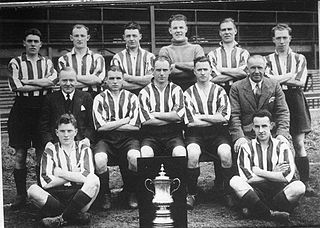
Sunderland Association Football Club is an English professional football club based in the city of Sunderland, Tyne and Wear. The team compete in the Championship, the second level of the English football league system.

The Stadium of Light is an all-seater football stadium in Sunderland, England, and the eighth and current home to Sunderland A.F.C. With space for 49,000 spectators, the Stadium of Light is the ninth largest football stadium in England. The stadium primarily hosts Sunderland A.F.C. home matches. The stadium was named by chairman Bob Murray to reflect the coal mining heritage of the North East and the former Monkwearmouth Colliery site on which it stands. A Davy lamp monument stands at the entrance to reflect the coal mining industry that brought prosperity to the town.
Sunderland Albion Football Club was an English association football club based in Sunderland, England, formed in 1888. Sunderland Albion and Sunderland A.F.C. were rivals for the period before Albion disbanded in 1892. The club was reformed in 2020 but has ceased operations as of 2022.

Kardinia Park is a sporting and entertainment venue located within Kardinia Park, South Geelong, in the Australian state of Victoria. The stadium, which is owned and operated by the Kardinia Park Stadium Trust, is the home ground of AFL club Geelong Football Club. The capacity of Kardinia Park is 40,000 making it the largest-capacity Australian stadium in a regional city.

Sunderland Association Football Club are an English association football club based in Sunderland, Tyne and Wear. They were formed in 1879, and played several years in the FA Cup and local cup competitions before joining the Football League in the 1890–91 season in place of Stoke. They played in the top league in England until the 1957–58, season when they were relegated into the Second Division. Sunderland are England's sixth most successful club of all time, having won the English League championship six times: in 1892, 1893, 1895, 1902, 1913, and, most recently, in 1936. They have also been runners-up on a further five occasions: in 1894, 1898, 1901, 1923 and 1935.

Sunderland Association Football Club Women is an English women's football club that plays in the Women's Championship. They play their home games at the Eppleton Colliery Welfare Ground in Hetton-le-Hole, in the City of Sunderland, Tyne and Wear.

The Tyne–Wear derby, also known as the North East derby, is a local derby between the association football clubs Sunderland and Newcastle United. The derby is an inter-city rivalry in North East England with the two cities of Sunderland and Newcastle upon Tyne just 12 miles (19 km) apart. Sunderland play their home matches at the Stadium of Light whilst Newcastle play their home matches at St. James’ Park. The first meeting of the two sides took place in 1883, with the first competitive fixture being an FA Cup tie in 1888 which Sunderland won 2–0 over Newcastle East End.

Muntz Street is the popular name of a former association football stadium situated in the Small Heath district of Birmingham, England, taken from the street on which it stood. During its lifetime the ground was known as Coventry Road; the name "Muntz Street" is a more recent adoption. It was the ground at which the teams of Birmingham City F.C. – under the club's former names of Small Heath Alliance, Small Heath and Birmingham – played their home games for nearly 30 years. It also served as the headquarters of the Small Heath Athletic Club.
James Richardson was a professional footballer and manager, who played for Third Lanark, Huddersfield Town, Sunderland, Ayr United and Millwall.

Newcastle Road was a football ground in the Monkwearmouth area of Sunderland, England, and was the home ground of Sunderland A.F.C for twelve years, between 1886 and 1898. It was the sixth ground at which the club had played. Also called Ashville Ground, it was located between Newcastle Road, Eglinton Street North and Crozier Street. Sunderland AFC's first game at the ground was a friendly against Birtley on 10 April 1886. The game ended as a 3 – 3 draw. On 5 May 1888, the now-defunct Sunderland Albion F.C. played their inaugural game at Newcastle Road; a 3 – 0 victory over Shankhouse Blackwatch, although Albion would go on to play their home games at Sunderland AFCs previous ground of Blue House Field.
William Murray was a football player and manager for Sunderland. He also played for Scottish League clubs Cowdenbeath and St Mirren.
Henry Forbes Low was a Scottish professional footballer who made over 200 appearances in the Football League for Sunderland as a left half. He also played in the Scottish League for Aberdeen.

Ephraim Rhodes was an English professional footballer and manager who played in the Football League for Sunderland in the early 20th century. He also played for and managed Brentford in the Southern League and was posthumously inducted into the club's Hall of Fame in May 2015.
Abbs Field was a football ground located in the Fulwell area of Sunderland. It was the home of Sunderland A.F.C. between 1884 and 1886, the fifth ground to host the club. Sunderland played their first game at Abbs Field on 27 September 1884, winning a friendly 2 - 1 against Birtley.
Groves Field was a football ground in the Ashbrooke area of Sunderland, England. It was the third home of Sunderland A.F.C, hosting the club between 1882 and 1883, and was Sunderland's last home South of the River Wear.
Blue House Field was a football ground in the Hendon area of Sunderland, England. It was the original home of Sunderland A.F.C hosting the club between 1880 and 1881. It hosted rivals Sunderland Albion F.C. between 1888 and 1892. While the home of Sunderland Albion, Blue House Field hosted matches in the Football Alliance and the FA Cup.







